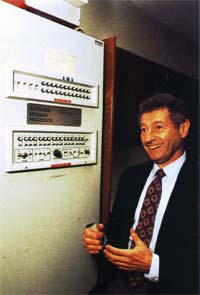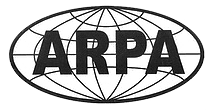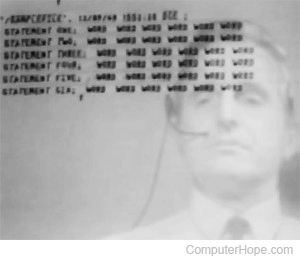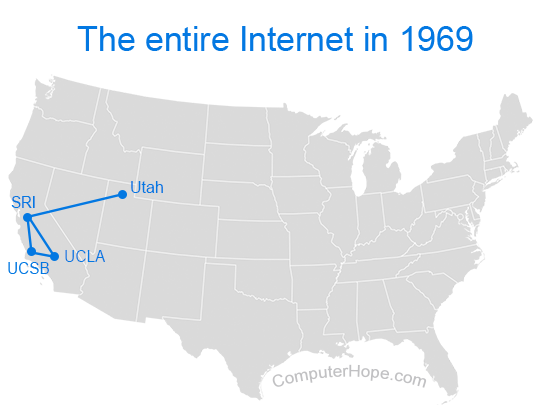History of the Internet
To see who invented the Internet and not a history of Internet events, see: Who invented the Internet?
1960
AT&T introduced the dataphone and the first known modem.
1961

Leonard Kleinrock published his first paper, "Information Flow in Large Communication Nets," on May 31, 1961.
1962
Leonard Kleinrock released his paper discussing packetization.
Paul Baran suggested data transmission using fixed-size message blocks in 1962.
J.C.R. Licklider became the first Director of IPTO and gave his vision of a galactic network.
1964
Paul Baran published reports On Distributed Communications in 1964.
Leonard Kleinrock published his first book on packet nets entitled Communication Nets: Stochastic Message Flow and Design in 1964.
1965
Lawrence G. Roberts with MIT performed the first long distant dial-up connection between a TX-2 computer in Massachusetts and Tom Marill with a Q-32 at SDC in California in 1965.
Donald Davies coined the word "Packet."
1966
Lawrence G. Roberts and Tom Marill published a paper about their earlier success connecting over dial-up in 1966.

Robert Taylor joined ARPA and brought Larry Roberts to develop ARPANET in 1966.
1967
Donald Davies created a 1-node NPL packet net in 1967.
Wes Clark suggested using a minicomputer for network packet switches in 1967.
1968

Doug Engelbart publicly demonstrated Hypertext on December 9, 1968, in The Mother of all Demos.
The first NWG (Network Working Group) meeting was held in 1968.
Larry Roberts published the ARPANET program plan on June 3, 1968.
The first RFP (request for proposal) for a network went out in 1968.
UCLA was selected to be the first node on the Internet as we know it today and served as the Network Msmnt Center in 1968.
1969
Steve Crocker released RFC #1 on April 7, 1969, introducing the Host-to-Host and discussing the IMP software.
UCLA released a press release introducing the public to the Internet on July 3, 1969.
On August 29, 1969, the first network switch and the first piece of network equipment (called "IMP," which was short for Interface Message Processor) was sent to UCLA.

On September 2, 1969, the first data moved from the UCLA host to the IMP switch.
CompuServe, the first commercial online service, was established in 1969.
1970
Steve Crocker and the UCLA team released NCP in 1970.
1971

Ray Tomlinson sent the first e-mail, the first messaging system to send messages across a network to other users, in 1971.
1972
The first public demo of ARPANET was in 1972.
Norman Abramson's Alohanet connected to ARPANET: packet radio nets in 1972.
1973
Vinton Cerf and Robert Kahn designed TCP in 1973 and later published it with the help of Yogen Dalal and Carl Sunshine in December 1974 in RFC 675.
ARPA deployed SATNET, the first international connection, in 1973.
Robert Metcalfe created the Ethernet at the Xerox PARC (Palo Alto Research Center).
The first VoIP call was made in 1973.
1974
A commercial version of ARPANET, known as Telenet, was introduced and considered by many to be the first ISP (Internet service provider) in 1974.
1978
TCP split into TCP/IP driven by Danny Cohen, David Reed, and John Shoch to support real-time traffic. The creation of TCP/IP also helped create UDP in 1978.
John Shoch and Jon Hupp at Xerox PARC developed the first worm in 1978.
1981
BITNET was founded in 1981.
1983
ARPANET standardized TCP/IP in 1983.
The IAB (Internet Activities Board) was founded in 1983.
1984
Paul Mockapetris and Jon Postel introduced DNS in 1984.
1986
Eric Thomas developed the first Listserv in 1986.
NSFNET was created in 1986.
BITNET II was created in 1986.
1988
The first T1 backbone was added to ARPANET in 1988.
Bitnet and CSNET merged to create CREN in 1988.
1989
On March 12, 1989, Tim Berners-Lee submitted a proposal for a distributed system at CERN, which would later become the WWW.
1990
ARPANET was replaced by NSFNET in 1990.
The first search engine, Archie, written by Alan Emtage, Bill Heelan, and Mike Parker at McGill University in Montreal, Canada, was released on September 10, 1990.
1991
Tim Berners-Lee introduced WWW, the first web page, and a website to the public on August 6, 1991.
NSF opened the Internet to commercial use in 1991.
On December 1, 1991, the first web server outside of Europe came online.
1992
Internet Society was formed in 1992.
MAE-East was created in 1992.
NSFNET upgraded to a T3 backbone in 1992.
1993
On April 30, 1993, CERN released the Web source code and made it public domain. The effect had an immediate effect as the Web experienced massive growth.
The White House and the United Nations came online in 1993 and helped start the .gov and .org top-level domains.
The NCSA released the Mosaic browser in 1993.
1994
Netscape (Mosaic Communications Corporation) was founded by Marc Andreessen and James H. Clark on April 4, 1994.
Mosaic Netscape 0.9, the first Netscape browser, was officially released on October 13, 1994. This browser also introduced the Internet to cookies.
WXYC (89.3 FM Chapel Hill, NC USA) became the first traditional radio station to broadcast on the Internet on November 7, 1994.
Tim Berners-Lee established and heads the W3C in October 1994.
1995
The dot-com boom started in 1995 after the NSFNET was shut down.
The SSL protocol was developed and introduced by Netscape in February 1995.
On April 1, 1995, the Opera browser was released.
The first VoIP software (Vocaltec) was released, allowing end users to make voice calls over the Internet.
On August 16, 1995, Microsoft introduced and released Microsoft Internet Explorer.
On November 24, 1995, HTML 2.0 was introduced in RFC 1866.
On December 4, 1995, Sun Microsystems announced JavaScript and released it in Netscape 2.0B3. In the same year, they also introduced Java.
1996
The Telecom Act deregulated data networks in 1996.
Now known as Adobe Flash, Macromedia Flash was introduced in 1996.
The first CSS specification, CSS 1, was published by the W3C in December 1996.
Sun introduced the Hotjava browser written in Java and the first browser capable of running Java applets.
More e-mail was sent than postal mail in the USA in 1996.
CREN ended its support, and since then, the network ceased to exist.
1997
Internet2 consortium was established in 1997.
IEEE released 802.11 (Wi-Fi) standard in 1997.
1998
Internet weblogs began to appear in 1998.
XML became a W3C recommendation on February 10, 1998.
1999
Napster started sharing files in September 1999.
On December 1, 1999, the most expensive Internet domain name, business.com, was sold by Marc Ostrofsky for $7.5 million. The domain was later sold again to R.H. Donnelley for $345 million on July 26, 2007.
2000
The dot-com bubble started to burst in 2000.
2003
January 7, 2003, CREN's members decided to dissolve the organization.
On June 30, 2003, the Safari browser was released for Apple computers.
2004

On November 9, 2004, Mozilla released the Mozilla Firefox browser.
2008
AOL ended support for the Netscape Internet browser on March 1, 2008.
On December 11, 2008, Google released the Chrome browser.
2009
A person under the fake name of Satoshi Nakamoto introduced the Internet currency bitcoin on January 3, 2009.
2014
The HTML5 programming language was recommended and released to the public on October 28, 2014, by W3C.
2015
Microsoft released its new Edge browser on April 29, 2015. Microsoft also bundled the Edge browser with Windows 10.
2019
A new version of the Microsoft Edge browser, based on the Chromium source code, was released to the public on April 8, 2019. Microsoft renamed the previous version of the Edge browser to Edge Legacy.
SpaceX launched its first 60 Starlink satellites in May 2019, operating in low Earth orbit and provide high-speed satellite Internet access to rural locations around the world.
